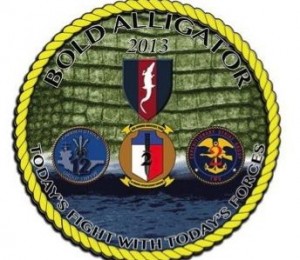2013-05-03 Last year, Second Line of Defense covered Bold Alligator 2012 from many angles: the French, coalition partners, the USMC, the Expeditionary Strike Group, etc.
The final report we produced has been downloaded by many of our readers.
This year’s exercise is a synthetic exercise, meaning that real world assets are involved but operate through a simulated link up and testing of combat operations, command relationships and other capabilities up against a complex scenario.

The scenario begins with an anti-access and area denial threat, and includes combat against regular forces and dealing with asymmetric threats from extremists. The approach looked to integrate USAF contributions (the I in ISR was crucial as well as lift), the 82nd Airborne dropped by C-17s and supported by those forces with the new air drop procedures honed in Afghanistan, the strike fleet providing cruise missile and air capabilities for the shaping function, along with Marines inserted to play a key role in the Anti-Access and Area Denial role, and, of course, the amphibious fleet and its air and related capabilities.
Especially noteworthy has been the testing of approaches for seabase support to the ground forces. Indeed, the challenge has been to mix the deployed forces with the proper support element.
A light logistics footprint has meant that the overall force protection and support requirements have been reduced. Rather than building mobile Walmarts, which then need to be protected, the model here is to support the engaged force with the right equipment and right supplies at the right place.
Our analyses of the French operation in Mali have highlighted the central role of expeditionary logistics in 21st century operations and Bold Alligator provides the sea-enabled version of this evolving capability.
https://sldinfo.com/the-french-in-mali-phase-two/
Several interviews will be published soon of the perspectives of key players in the exercise.
A key interview was with the 2nd Expeditionary Strike Commander and with the Marine Expeditionary Brigade commander.
This joint interview highlighted a number of key elements of shaping a more flexible and scalable force for 21st century operations.
In the video excerpt below, Brigadier General Love, Deputy Commanding General, II Marine Expeditionary Force; and Commanding General, 2d Marine Expeditionary Brigade, discusses the concept of operations tested in Bold Alligator 2013.
For General Love’s bio see the following:
https://slsp.manpower.usmc.mil/gosa/biographies/rptBiography.asp?PERSON_ID=2980&PERSON_TYPE=General
Editor’s Note: A key challenge facing the U.S. and its allies is to ensure that the politicians and strategists understand this new and evolving flexibility and shape proper understanding of when and how to use this capability.
For example, with regard to Syria, the positions taken have largely been either to do a significant land insertion to support the “rebels” or to put red lines in the sand to ensure that chemical weapons are not used.
Not discussed at all was how might we use this new flexible force to go in and grab the weapons one can and leave, without fully resolving the fate of Syria for the 21st century.
Limited objectives, limited means but robust capabilities provide policy options, if the policy class puzzles over evolving capabilities.
For an overview video produced by the 2nd Expeditionary Strike Group on the Bold Alligator 2013 exercise see below:

